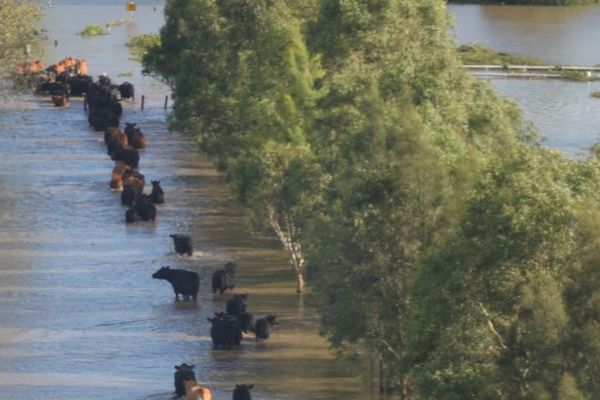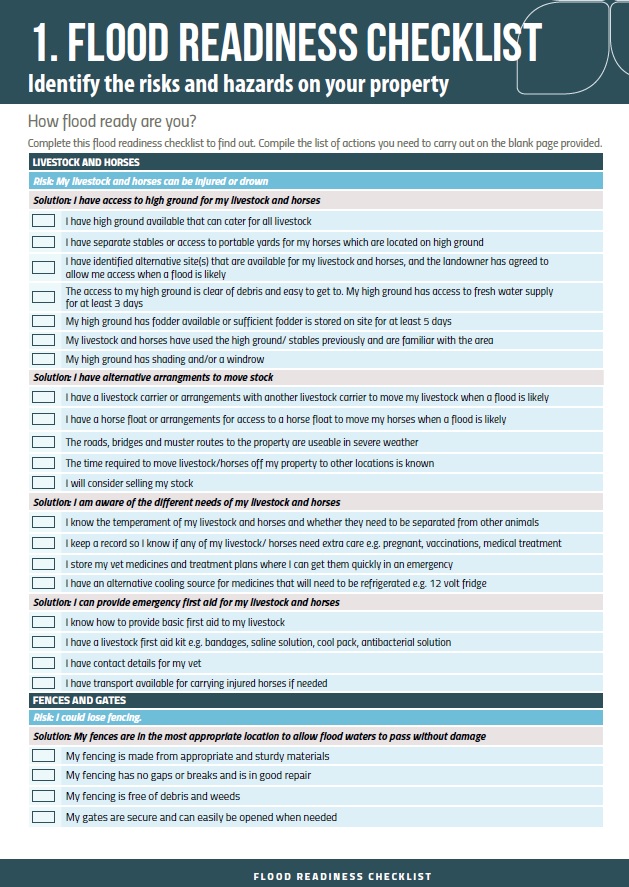Flood Preparation
There are things you can do before a flood to ensure your property is flood-ready.
It's important to know how to prepare your farm and property for flood.
Where possible, flood planning in advance and preparing your property early will keep your livestock safe, and allow you to recover more quickly so you're able to get back to business.
Flood preparedness means thinking ahead about safe access routes, whether livestock should be moved to higher ground, and if you have enough supplies should your property become isolated.
FARM FLOOD READINESS KIT
Be flood-ready. We encourage landholders to read about preparing a personalised Farm Flood Readiness Kit.
Get useful tips on how you can make your property flood-ready. Use the flood readiness checklist to help you identify the risks and hazards on your property and develop an action list.
Download the Farm Flood Readiness PDF to make it easy to find out where to get information about floods and warnings.
Why is it important to be prepared for a flood?
Being prepared and ensuring your farm is flood-ready helps you to recover more quickly and get back to business sooner.
The damage to farm property and asset losses caused by floods can be very high. It costs a lot of money and takes a long time to clean up your property, repair fences and feed livestock. It is cheaper to plan ahead and be prepared than pay the costs of repairs or lose income and production time.
When you live on a floodplain having a flood plan just makes good farming sense. Good flood planning will help protect your home, property and business. You also have an obligation to protect your livestock and pets from drowning. Your flood plan doesn’t have to be complicated. In fact, it needs to be as easy and straightforward as possible so that if you are away someone else can implement it on your behalf.
Every flood is different, so landholders should plan for all risks and possible impacts.

What to include in a farm flood plan?
Know what your risks are - complete the flood readiness checklist and identify the risks and hazards on your property
Know what to do to reduce risks - develop an action list to reduce your risks and make your property flood ready
Know what to do when a flood is coming - develop a flood plan and ensure you know where to get information about floods and warnings
Below are some examples of risks and actions that might be included in a flood plan.
Do you have livestock or other animals?
Have safe high ground with access to food, clean water and shelter. Keep up to date with warnings and start moving livestock early.
Can your property be isolated during floor?
Store food, clean water, battery radio, generator, fuel, first aid kit and emergency contacts. Move necessities above expected flood levels. Make sure they remain dry.
Do you store chemicals on your property?
Store in a shed off the ground so they can’t be washed away. Ensure all chemicals are stored and shed securely locked.
What to do when there is threat of flood
Our flood readiness kit will help you know how to prepare your farm in case of flood.
We also encourage you to follow your Local Land Services Facebook page for further updates and advice
Flood Watch
- Move livestock and horses to higher ground on or off property and make sure they have access to clean water and food
- Ensure all animals are in a safe area where they cannot be trapped by rising floodwater
- Remove pumps from waterways
- Move equipment where possible –tractors, farming equipment, utes and other vehicles
- Secure moveable objects such as shipping containers and bale feeders
- Remove debris from paddocks – irrigation pipes, timber, scrap, metal, tools etc
- Store all chemicals securely and out of potential floodwater level
- Check that your emergency kit is ready – include portable radio, torch, batteries, first aid kit, food and water for five days
- Make sure you have essential documents at hand – emergency contact list, legal documents and accounting records.
- Check on neighbours where possible.
Flood Warning
- Always stay up to date with emergency warnings and other public messages so you know if things are likely to change and what to do
- Stay in touch with nominated contacts
- Seal areas around the home and other farm buildings to keep out water and vermin
- Lock storage sheds and sandbag where necessary to prevent water entering
- Keep pets safe and out of floodwater
- Send staff and visitors home
- Be prepared in the event you have to evacuate
- If you plan to leave, leave early.
Evacuation Warning
- Act Early
- Be prepared to evacuate with your pets and emergency kit
- Stay up to date with emergency warnings and public messages.
What to do after a flood?
Local Land Services can offer flood recovery support for primary producers with on-farm clean-up advice, vet services to help with animal health, advice on pasture recovery, as well as long-term ongoing capacity building and skills development through funding and grants.
EMERGENCY FLOOD PLAN AND OTHER RESOURCES
If you require other assistance due to flood and storm emergencies, please phone NSW State Emergency Service (SES) on 132 500. In life-threatening emergencies call triple zero (000).
It’s very hard to respond to a flood efficiently without the proper preparation and planning, as is the case with most natural disasters.
The NSW State Emergency Service (SES) has created an emergency floodsafe plan for your household or business. They also provide resources to help you prepare an Animal Emergency Plan for your livestock and other animals.
Visit NSW SES website for current storm and flood advice for your area.
The NSW Department of Planning, Industry and Environment also provides information on surface and groundwater management as well as real-time water information and data.